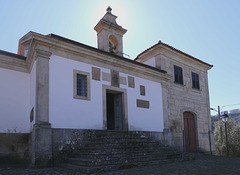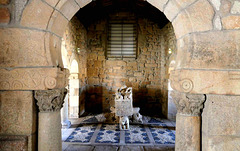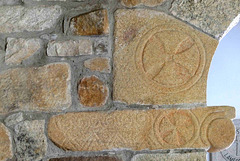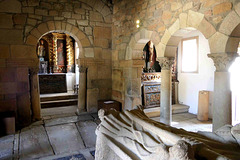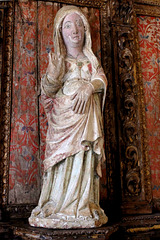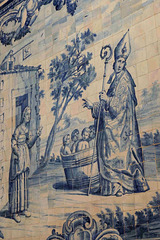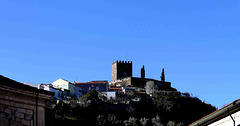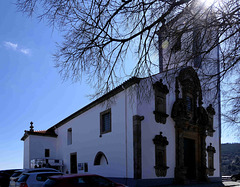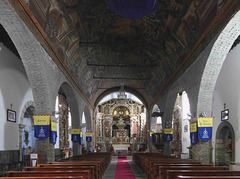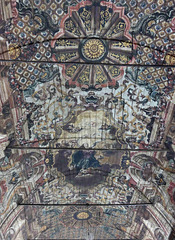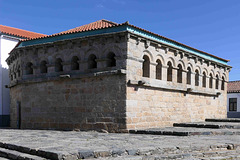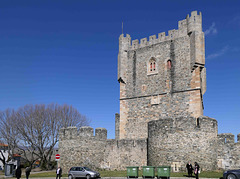
Portugal / Região Norte
Lamego - Capela de São Pedro de Balsemão
| |
|
Behind the baroque façade of the Capela de São Pedro de Balsemão is perhaps the oldest church in Portugal, dating back to the 7th century.
Lamego - Capela de São Pedro de Balsemão
| |
|
|
Behind the baroque façade of the Capela de São Pedro de Balsemão is perhaps the oldest church in Portugal, dating back to the 7th century.
It was a Visigothic (some say Suebi) sanctuary dating back to the 7th century.
In the location of the chapel was a Roman villa, which can be dated from inscriptions from the period of Claudius, as some of the Roman stones were reused here. Balsemão was already an ecclesiastical parish already in the 6th century. In the 10th century, with the repopulation of the area, the church was renovated. The church was profoundly transformed after the 14th century, when the Bishop of Porto, Afonso Pires, selected the chapel to bury his earthly remains. His sarcophagus is today located in the principal nave.
Lamego - Capela de São Pedro de Balsemão
| |
|
Behind the baroque façade of the Capela de São Pedro de Balsemão is perhaps the oldest church in Portugal, dating back to the 7th century.
It was a Visigothic (some say Suebi) sanctuary dating back to the 7th century.
In the location of the chapel was a Roman villa, which can be dated from inscriptions from the period of Claudius, as some of the Roman stones were reused here. Balsemão was already an ecclesiastical parish already in the 6th century. In the 10th century, with the repopulation of the area, the church was renovated. The church was profoundly transformed after the 14th century, when the Bishop of Porto, Afonso Pires, selected the chapel to bury his earthly remains. His sarcophagus is today located in the principal nave.
Wall ornaments
Lamego - Capela de São Pedro de Balsemão
| |
|
|
Behind the baroque façade of the Capela de São Pedro de Balsemão is perhaps the oldest church in Portugal, dating back to the 7th century.
It was a Visigothic (some say Suebi) sanctuary dating back to the 7th century.
In the location of the chapel was a Roman villa, which can be dated from inscriptions from the period of Claudius, as some of the Roman stones were reused here. Balsemão was already an ecclesiastical parish already in the 6th century. In the 10th century, with the repopulation of the area, the church was renovated. The church was profoundly transformed after the 14th century, when the Bishop of Porto, Afonso Pires, selected the chapel to bury his earthly remains. His sarcophagus is today located in the principal nave.
Wall ornaments
Lamego - Capela de São Pedro de Balsemão
| |
|
Behind the baroque façade of the Capela de São Pedro de Balsemão is perhaps the oldest church in Portugal, dating back to the 7th century.
It was a Visigothic (some say Suebi) sanctuary dating back to the 7th century.
In the location of the chapel was a Roman villa, which can be dated from inscriptions from the period of Claudius, as some of the Roman stones were reused here. Balsemão was already an ecclesiastical parish already in the 6th century. In the 10th century, with the repopulation of the area, the church was renovated. The church was profoundly transformed after the 14th century, when the Bishop of Porto, Afonso Pires, selected the chapel to bury his earthly remains. His sarcophagus is today located in the principal nave.
Wall ornaments
Lamego - Capela de São Pedro de Balsemão
| |
|
Behind the baroque façade of the Capela de São Pedro de Balsemão is perhaps the oldest church in Portugal, dating back to the 7th century.
It was a Visigothic (some say Suebi) sanctuary dating back to the 7th century.
In the location of the chapel was a Roman villa, which can be dated from inscriptions from the period of Claudius, as some of the Roman stones were reused here. Balsemão was already an ecclesiastical parish already in the 6th century. In the 10th century, with the repopulation of the area, the church was renovated. The church was profoundly transformed after the 14th century, when the Bishop of Porto, Afonso Pires, selected the chapel to bury his earthly remains. His sarcophagus is today located in the principal nave.
Lamego - Capela de São Pedro de Balsemão
Lamego - Capela de São Pedro de Balsemão
| |
|
Behind the baroque façade of the Capela de São Pedro de Balsemão is perhaps the oldest church in Portugal, dating back to the 7th century.
It was a Visigothic (some say Suebi) sanctuary dating back to the 7th century.
In the location of the chapel was a Roman villa, which can be dated from inscriptions from the period of Claudius, as some of the Roman stones were reused here. Balsemão was already an ecclesiastical parish already in the 6th century. In the 10th century, with the repopulation of the area, the church was renovated. The church was profoundly transformed after the 14th century, when the Bishop of Porto, Afonso Pires, selected the chapel to bury his earthly remains. His sarcophagus is today located in the principal nave.
La Virgen de la Expectación / A pregnant Virgin
Lamego - Lavandaria
| |
|
|
Lamego became Catholic when the Visigothic king Rekared I converted to Catholicism. During the reign of Sisebuto (612-621), the Visigothic monarch coined currency from Lamego, indicating the importance of the region to commerce and culture.
The region alternated between Christian and Muslim hands during the early Reconquista Period. The city was first conquered by Alfonso I of Asturias in 741and repopulated in 868 by Alfonso III. It fell into Islamic hands briefly again during the late 10th century, until Ferdinand I of León and Castile conquered the region definitively in 1057.
The most significant moment in the town's history was in 1139, when nobles declared Afonso Henriques to be Portugal's first king.
Lavandaria "La Wash"
Lamego - Sé de Lamego
| |
|
Lamego became Catholic when the Visigothic king Rekared I converted to Catholicism. During the reign of Sisebuto (612-621), the Visigothic monarch coined currency from Lamego, indicating the importance of the region to commerce and culture.
The region alternated between Christian and Muslim hands during the early Reconquista Period. The city was first conquered by Alfonso I of Asturias in 741and repopulated in 868 by Alfonso III. It fell into Islamic hands briefly again during the late 10th century, until Ferdinand I of León and Castile conquered the region definitively in 1057.
The most significant moment in the town's history was in 1139, when nobles declared Afonso Henriques to be Portugal's first king.
The diocese of Lamego may have been founded around 570; in any case, as bishop's names are known from this period. After the reconquest of the north of what is now Portugal by Ferdinand I of León in 1057, it continued to exist de facto, but it was not until four years after Portugal's independence (1139) that the bishopric was refounded by King Alfonso I in 1143. The bell tower of the current cathedral dates back to this time, but it was fundamentally altered in the 16th century in the late Gothic/Renaissance style. In 1881, Pope Leo XIII attached the bishopric of Lamego to the archbishopric of Braga.
Lamego - Sé de Lamego
| |
|
Lamego became Catholic when the Visigothic king Rekared I converted to Catholicism. During the reign of Sisebuto (612-621), the Visigothic monarch coined currency from Lamego, indicating the importance of the region to commerce and culture.
The region alternated between Christian and Muslim hands during the early Reconquista Period. The city was first conquered by Alfonso I of Asturias in 741and repopulated in 868 by Alfonso III. It fell into Islamic hands briefly again during the late 10th century, until Ferdinand I of León and Castile conquered the region definitively in 1057.
The most significant moment in the town's history was in 1139, when nobles declared Afonso Henriques to be Portugal's first king.
The diocese of Lamego may have been founded around 570; in any case, as bishop's names are known from this period. After the reconquest of the north of what is now Portugal by Ferdinand I of León in 1057, it continued to exist de facto, but it was not until four years after Portugal's independence (1139) that the bishopric was refounded by King Alfonso I in 1143. The bell tower of the current cathedral dates back to this time, but it was fundamentally altered in the 16th century in the late Gothic/Renaissance style. In 1881, Pope Leo XIII attached the bishopric of Lamego to the archbishopric of Braga.
St. Nicholas and the three little children, who had been lured by a malicious butcher into his house, where he killed them, placing their remains in a barrel to cure, planning to sell them off as ham. Nicholas saw through the butcher's lies and resurrected the pickled children.
Lamego - Castelo de Lamego
| |
|
Lamego became Catholic when the Visigothic king Rekared I converted to Catholicism. During the reign of Sisebuto (612-621), the Visigothic monarch coined currency from Lamego, indicating the importance of the region to commerce and culture.
The region alternated between Christian and Muslim hands during the early Reconquista Period. The city was first conquered by Alfonso I of Asturias in 741and repopulated in 868 by Alfonso III. It fell into Islamic hands briefly again during the late 10th century, until Ferdinand I of León and Castile conquered the region definitively in 1057.
The most significant moment in the town's history was in 1139, when nobles declared Afonso Henriques to be Portugal's first king.
The castle towers over the town.
Douro
Bragança - Igreja de Santa Maria
| |
|
In Roman times, the region belonged to the province of Gallaecia and was under the administration of Asturica Augusta (now Astorga).
The Romans were followed by the Visigoths and Suebi, who incorporated this region into their empire and introduced wheat cultivation. The first documentary mention of the settlement that developed into today's Bragança was found in the records of the Council of Lugo in 569. Under the administration of King Wamba, the town was recorded as Bregancia in 666.
From 711, the Visigoths were expelled by the Moors. The area was probably sparsely populated when the Reconquista emerged and pushed the Moors southwards. Due to its location on strategic transport routes, Bragança became increasingly important, especially after Portugal gained independence in 1139. King D. Sancho I rebuilt the badly damaged town, refortified it and granted it city rights in 1187. In 1199, D. Sancho I freed the town from the siege by Alfonso IX and established the current Portuguese place name.
In the course of the revolution of 1383 and the attempt by the hereditary Castile to take over Portugal, Bragança fell to its neighbour. It has been Portuguese again since 1401
Located within the walls of the Citadel of Bragança, it was built in the 14th century. Considered to be the oldest church in the city, this Romanesque church was modified over two centuries, resulting in a Baroque style.
Bragança - Igreja de Santa Maria
| |
|
|
|
In Roman times, the region belonged to the province of Gallaecia and was under the administration of Asturica Augusta (now Astorga).
The Romans were followed by the Visigoths and Suebi, who incorporated this region into their empire and introduced wheat cultivation. The first documentary mention of the settlement that developed into today's Bragança was found in the records of the Council of Lugo in 569. Under the administration of King Wamba, the town was recorded as Bregancia in 666.
From 711, the Visigoths were expelled by the Moors. The area was probably sparsely populated when the Reconquista emerged and pushed the Moors southwards. Due to its location on strategic transport routes, Bragança became increasingly important, especially after Portugal gained independence in 1139. King D. Sancho I rebuilt the badly damaged town, refortified it and granted it city rights in 1187. In 1199, D. Sancho I freed the town from the siege by Alfonso IX and established the current Portuguese place name.
In the course of the revolution of 1383 and the attempt by the hereditary Castile to take over Portugal, Bragança fell to its neighbour. It has been Portuguese again since 1401
Located within the walls of the Citadel of Bragança, it was built in the 14th century. Considered to be the oldest church in the city, this Romanesque church was modified over two centuries, resulting in a Baroque style.
Bragança - Igreja de Santa Maria
| |
|
In Roman times, the region belonged to the province of Gallaecia and was under the administration of Asturica Augusta (now Astorga).
The Romans were followed by the Visigoths and Suebi, who incorporated this region into their empire and introduced wheat cultivation. The first documentary mention of the settlement that developed into today's Bragança was found in the records of the Council of Lugo in 569. Under the administration of King Wamba, the town was recorded as Bregancia in 666.
From 711, the Visigoths were expelled by the Moors. The area was probably sparsely populated when the Reconquista emerged and pushed the Moors southwards. Due to its location on strategic transport routes, Bragança became increasingly important, especially after Portugal gained independence in 1139. King D. Sancho I rebuilt the badly damaged town, refortified it and granted it city rights in 1187. In 1199, D. Sancho I freed the town from the siege by Alfonso IX and established the current Portuguese place name.
In the course of the revolution of 1383 and the attempt by the hereditary Castile to take over Portugal, Bragança fell to its neighbour. It has been Portuguese again since 1401
Located within the walls of the Citadel of Bragança, it was built in the 14th century. Considered to be the oldest church in the city, this Romanesque church was modified over two centuries, resulting in a Baroque style.
The painted ceiling
Bragança - Domus Municipalis
| |
|
|
In Roman times, the region belonged to the province of Gallaecia and was under the administration of Asturica Augusta (now Astorga).
The Romans were followed by the Visigoths and Suebi, who incorporated this region into their empire and introduced wheat cultivation. The first documentary mention of the settlement that developed into today's Bragança was found in the records of the Council of Lugo in 569. Under the administration of King Wamba, the town was recorded as Bregancia in 666.
From 711, the Visigoths were expelled by the Moors. The area was probably sparsely populated when the Reconquista emerged and pushed the Moors southwards. Due to its location on strategic transport routes, Bragança became increasingly important, especially after Portugal gained independence in 1139. King D. Sancho I rebuilt the badly damaged town, refortified it and granted it city rights in 1187. In 1199, D. Sancho I freed the town from the siege by Alfonso IX and established the current Portuguese place name.
In the course of the revolution of 1383 and the attempt by the hereditary Castile to take over Portugal, Bragança fell to its neighbour. It has been Portuguese again since 1401
The Domus Municipalis dates back to a cistern that was built in the 13th or 14th century. An upper floor was built above the cistern, which served as the town hall until the 19th century. From the middle of the 15th century, the building is referred to as a cistern for rain and spring water. From 1503, the use of the upper floor as a meeting place is documented.
The building is constructed from massive granite blocks. The medieval cistern is covered by a barrel vault. The upper floor, which is used as a meeting room, has an irregular, pentagonal floor plan. Corbels decorated with depictions of animals and people are arranged under the roof base. The interior is covered by a wooden roof truss.
Bragança - Castelo de Bragança
| |
|
|
In Roman times, the region belonged to the province of Gallaecia and was under the administration of Asturica Augusta (now Astorga).
The Romans were followed by the Visigoths and Suebi, who incorporated this region into their empire and introduced wheat cultivation. The first documentary mention of the settlement that developed into today's Bragança was found in the records of the Council of Lugo in 569. Under the administration of King Wamba, the town was recorded as Bregancia in 666.
From 711, the Visigoths were expelled by the Moors. The area was probably sparsely populated when the Reconquista emerged and pushed the Moors southwards. Due to its location on strategic transport routes, Bragança became increasingly important, especially after Portugal gained independence in 1139. King D. Sancho I rebuilt the badly damaged town, refortified it and granted it city rights in 1187. In 1199, D. Sancho I freed the town from the siege by Alfonso IX and established the current Portuguese place name.
In the course of the revolution of 1383 and the attempt by the hereditary Castile to take over Portugal, Bragança fell to its neighbour. It has been Portuguese again since 1401
The Castle of Bragança has seen a turbulent history that saw occupation during the Moorish period to the devastation and reconstruction that accompanied the Christian reconquest. The castle was brought under control of King Afonso I of Portugal (1112-1185). For defensive reasons, the village was moved to the current site; It was near the hill of Benquerença on the sidelines of Fervença river, reusing them materials in the construction of new homes and a castle for defense of the people.
King Sancho I (1185-1211) endowed the village with funds to construct a wall and castle in 1187. During this time, the conflict between Sancho I and León resulted in violence and saw Leonese forces taken over the village.
During the reign of King Denis (1279-1325), the village erected a walled perimeter in 1293, signifying a prosperity of the village.
Bragança - Castelo de Bragança
| |
|
|
In Roman times, the region belonged to the province of Gallaecia and was under the administration of Asturica Augusta (now Astorga).
The Romans were followed by the Visigoths and Suebi, who incorporated this region into their empire and introduced wheat cultivation. The first documentary mention of the settlement that developed into today's Bragança was found in the records of the Council of Lugo in 569. Under the administration of King Wamba, the town was recorded as Bregancia in 666.
From 711, the Visigoths were expelled by the Moors. The area was probably sparsely populated when the Reconquista emerged and pushed the Moors southwards. Due to its location on strategic transport routes, Bragança became increasingly important, especially after Portugal gained independence in 1139. King D. Sancho I rebuilt the badly damaged town, refortified it and granted it city rights in 1187. In 1199, D. Sancho I freed the town from the siege by Alfonso IX and established the current Portuguese place name.
In the course of the revolution of 1383 and the attempt by the hereditary Castile to take over Portugal, Bragança fell to its neighbour. It has been Portuguese again since 1401
The Castle of Bragança has seen a turbulent history that saw occupation during the Moorish period to the devastation and reconstruction that accompanied the Christian reconquest. The castle was brought under control of King Afonso I of Portugal (1112-1185). For defensive reasons, the village was moved to the current site; It was near the hill of Benquerença on the sidelines of Fervença river, reusing them materials in the construction of new homes and a castle for defense of the people.
King Sancho I (1185-1211) endowed the village with funds to construct a wall and castle in 1187. During this time, the conflict between Sancho I and León resulted in violence and saw Leonese forces taken over the village.
During the reign of King Denis (1279-1325), the village erected a walled perimeter in 1293, signifying a prosperity of the village.
Jump to top
RSS feed- Latest items - Subscribe to the latest items added to this album
- ipernity © 2007-2024
- Help & Contact
|
Club news
|
About ipernity
|
History |
ipernity Club & Prices |
Guide of good conduct
Donate | Group guidelines | Privacy policy | Terms of use | Statutes | In memoria -
Facebook
Twitter

